2025 Venice Biennale Fellowship Programme Launched
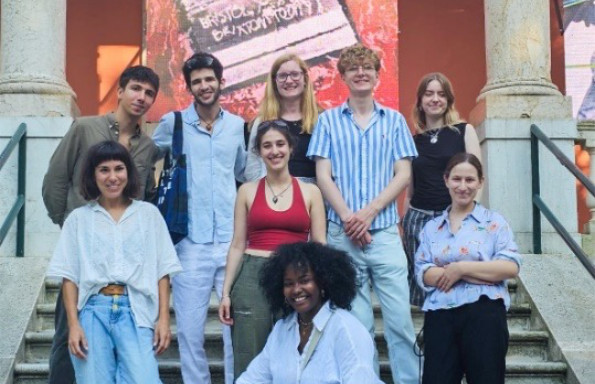
We have launched applications for the 2025 Venice Architecture Biennale British Council Fellowship Programme. Visit the Virtual LSA for details if you are an MArch 4 or a PHD student and want to apply.
The 2025 Venice Architecture Biennale British Council Fellowship Programme
Please read below form one of our 2024 Fellows
Alice Holmes Fellow 2024
60th International Art Biennale in Venice : FOREIGNERS EVERYWHERE - curated by Adriano Pedrosa
I feel incredibly privileged to have the opportunity to be a fellow from June to July at the Venice Biennale this year through the Liverpool School of Architecture and the British Council, something I never imagined I would have the chance to do. It’s an experience that I will carry with me for the rest of my life—and one I’ve found myself talking about almost every day. I first heard about this opportunity during a talk by last year's Liverpool School of Architecture fellows, Toby and Keisha, and I’m so glad I attended as the opportunity to spend a funded month anywhere is incredibly rare, but the chance to live in Venice even more so.
In the run up to going to Venice we had meetings with Sandy Britton who coordinated the programme within the University of Liverpool and weekly teams meetings run by Becky Schutt, Sophie Lucas and Francesca Vason from the British Council and M+B Studio coordinators Anna and Francesco where we were able to meet members from our group, learn about living in Venice as well as about the artist Sir John Akomfrah whose exhibition we would be invigilating. Initially, I was a bit apprehensive about meeting my group, as most of them were art students while I came from an architecture background. I assumed they’d be more "arty" than I was but in reality, we turned out to be very similar, and I quickly felt at ease. Being surrounded by a great group of people made the experience so much easier. None of us had lived in Venice or visited the Biennale before, so we were all navigating it together for the first time.
Being part of its inner workings of the Venice Biennale was a great experience, giving me the opportunity to engage with visitors about the artwork as well as the M+B Studio pavilion coordinators, Anna and Francesco about what it had been like in previous years. These conversations are currently influencing my university studies, especially my dissertation research on the history of the British Pavilion. I’d like to extend my gratitude to Sophie Lucas from the British Council for her invaluable help with this since I have returned home. The volume of art, both within the Biennale grounds and in the collateral events across the city, was overwhelming in the best way. My favorite was an exhibition at the Arsenale called Bouchra Khalili: The Mapping Journey, which explored transnational migrations. I found the piece incredibly moving and very different from anything I had seen before. The exhibition within the British Pavilion was called ‘Listening all night to the rain’ and was created by artist Sir John Akomfrah and curator Tarini Malik. Having the opportunity to spend two days a week in the exhibition allowed us to experience it in a different way than that of the typical visitors. At first, I found the exhibit quite complex and hard to fully understand. However, the more time I spent there, the more themes I began to identify and the more I enjoyed the piece. It was also fascinating to see how the architecture of the British Pavilion was utilized as this was the first year that visitors entered through the back of the building rather than the grand entrance at the front which is something I’m now looking at within my university studies.
Images below first one credit to fellow Youssef ElNahas and second to myself, Alice Holmes
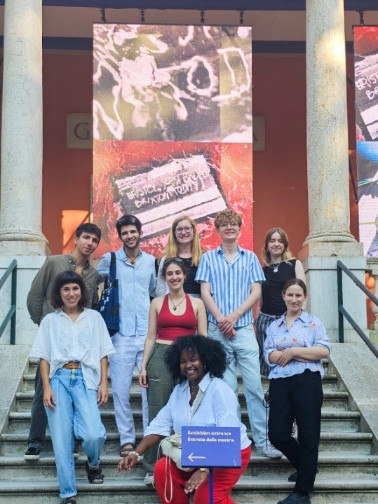
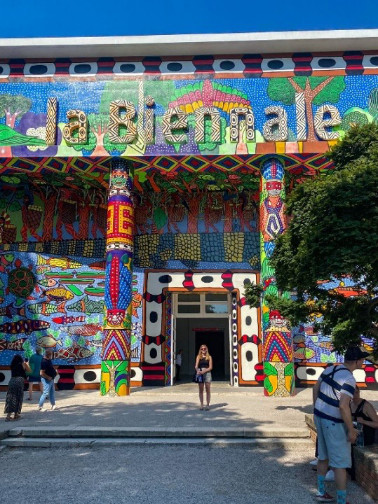
Being in Venice for a month gave me the rare chance to explore the majority of the city. I made it my mission to walk the entire island, though with Venice’s maze-like streets, I can’t be 100% sure I covered it all. But while exploring the city, I noticed a number of unique features that set Venice apart from other places, particularly its bridges. For my project that I undertook while I was there, I began cataloging the bridges in the Castello district, creating a system of symbols to compare their various elements. Additionally, some other members of my group were working on similar projects that cataloged different aspects of Venice, and we hope to combine our findings into a collaborative project by the end of the year.
I also visited many of the surrounding islands with my group, with Burano being my favorite as its distance from the main island meant fewer tourists, and on a sunny day, its brightly colored houses made it especially picturesque. I was also drawn to San Michele, the cemetery island, which was incredibly peaceful and offered a break from the bustling tourist spots of the main island. The David Chipperfield architecture on the island was also very worth visiting and I felt particularly inspired by the way their architecture practice utilized light and shadows to make the space feel less enclosed.
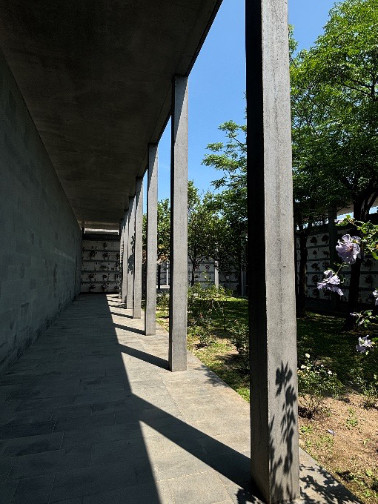
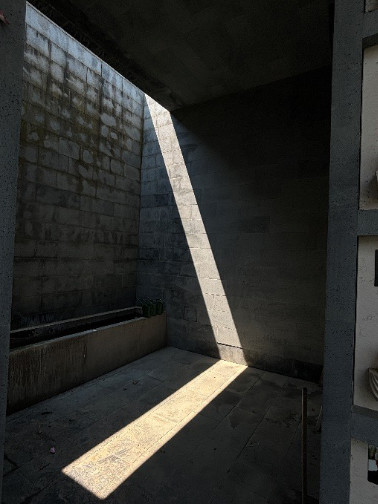
The David Chipperfield buildings on San Michele Island taken by myself.
I quickly realized soon after arriving in Venice that it as a city exists in two forms: by day, it’s packed with tourists, loud and almost chaotic in certain areas. But in the early mornings and evenings, it becomes a much quieter, slower-paced place, almost like a village, with local festivals and events. A highlight for me was the local Sagras which were traditional festivals held in different squares across the main island. In these we met other Biennale invigilators from different countries including the Irish and Singapore pavilion invigilators as well as students from IUAV University and those working at the Peggy Guggenheim Gallery. At the Sagras, we had the opportunity to get to know each other as well as enjoying live music performed by local musicians, along with delicious local food and drinks.
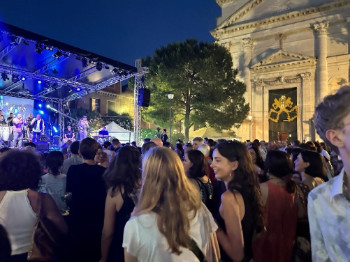
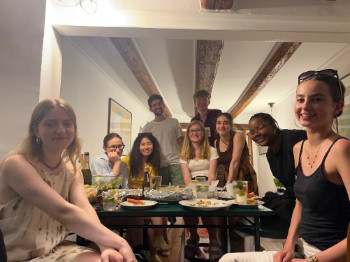
The first photo is of the Sagra taken by fellow Caterina Edrich
The second is a Meal we made as a group with M+B coordinators Anna and Francesco taken by myself Alice Holmes
Overall, I’m incredibly grateful to the University of Liverpool for giving me this opportunity, and to Sandy for all the organization that made it possible. I also want to thank the British Council for allowing me to be part of such an amazing experience and to join the network of fellows who have worked at the British Pavilion during the Venice Biennale. I’d also like to thank Francesco and Anna from M+B Studio for their support in the pavilion and for showing us all the best parts of Venice. This month has had a huge impact on me and I'm excited to build on the friendships I made and to see how the experiences I had will shape my studies and upcoming projects.
I’d like to invite anyone reading this article to join us for a talk in early November in the Liverpool School of Architecture, where Amber Potts and I will share more about our experiences in Venice and the projects we worked on during our time there.